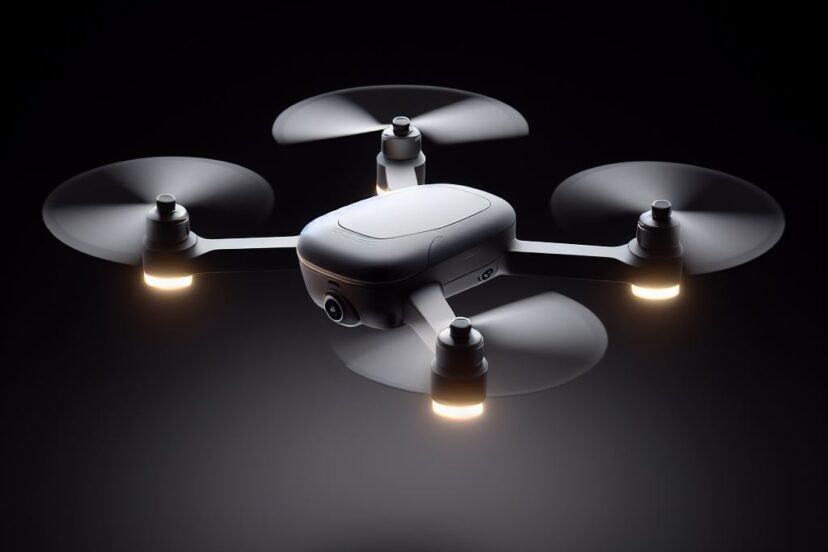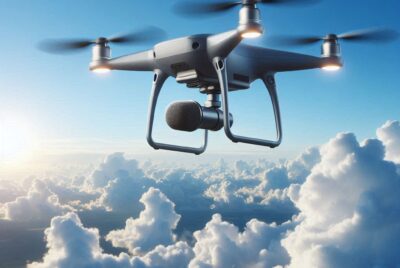Drone Lights: Illuminating Your Aerial Adventures
*We may earn a commission for purchases made using our links. Please see our disclosure to learn more.
Drone Lights: Enhancing Visibility and Safety for Nighttime Flights
I understand the importance of drone lights, especially when operating drones during low light conditions such as twilight or night. Equipping drones with the appropriate lighting not only enhances visibility but is also a requirement by the Federal Aviation Administration (FAA) for night flying. There are specific guidelines that dictate the use of anti-collision lights to ensure that drones are visible to other aircraft during night flights.

With the advancements in drone technology, flying at night has become increasingly feasible. However, with this capability comes the responsibility of understanding the FAA regulations that pertain to night operations. The FAA stipulates that drones must have lights strong enough to be seen from a distance of at least three miles during civil twilight and at night. Civil twilight is a period defined by the FAA as being 30 minutes before sunrise and 30 minutes after sunset. During these times, visibility is reduced and the use of lights on drones becomes critical for safe operation.
As someone who keeps up with the latest in drone technology, I’ve seen an array of lights designed for drones, including anti-collision, search, and scene lights. Some lights provide various color and brightness settings to ensure compatibility with different drone models, including lightweight foldable drones. When flying at night, the right drone lights not only comply with regulations but also offer additional benefits, such as better visibility for the operator and the ability to capture stunning aerial footage even in low-light conditions.
Types and Purposes of Drone Lights
As an expert on the subject, I’ll guide you through the key types of drone lights and their specific functions. Each category serves a distinct purpose, from ensuring the safety of the drone during flight to enhancing the quality of aerial images.
Visibility and Navigation
Navigation lights are crucial for maintaining visual orientation of drones during low-light conditions or at night. Typically, drones are equipped with red and green lights to mimic the standard aviation light configuration: red on the left side and green on the right. This allows both the pilot and bystanders to determine the drone’s direction of flight.
Anti-Collision Lighting
Anti-collision lights, such as strobe lights, are especially important to ensure drones are visible to other aircraft. These strobe-capable lights, which are required by the FAA for night flights under FAR 107.29, should be visible from 3 statute miles away. Manufacturers like FoxFury design these lights to flash at a rate of 40-100 times per minute to signal the presence of the drone to others in the airspace effectively.
Photography and Videography
For creative applications, lighting solutions like the Lume Cube provide adjustable illumination that enhances photo and video quality. These lights offer drones the ability to illuminate subjects from the air, opening up a world of opportunity for photographers and filmmakers to capture high-quality content in low-light conditions.
Regulatory Compliance

In this section, I’ll discuss the specific criteria for regulatory compliance in regard to drone lights, particularly during night flight operations as directed by the FAA. Adhering to these guidelines is not only mandatory for legal flight but also ensures safety and visibility.
FAA Requirements for Night Flights
The FAA mandates that drones flying at night must be equipped with anti-collision lights. These lights must be visible for at least three statute miles and have a flash rate sufficient to avoid any confusion with other aircraft.
Key aspects of night flight regulations involve:
- Visibility: Anti-collision lights must allow for visibility by the pilot and any other airspace users.
- Operation Hours: Night flights are defined by the FAA as those that take place between civil twilight, which is 30 minutes after sunset, until 30 minutes before sunrise.
Part 107 Rules and Exemptions
Part 107 of the FAA regulations provides the framework for non-hobbyist small unmanned aircraft systems (sUAS) operations. Complying with Part 107 is essential for legal drone operation. When it comes to waivers and exemptions, specifically for night operations, operators must:
- Obtain a Part 107.29 waiver if they plan to fly at night without following standard night time conditions.
- Demonstrate that the operation can be conducted safely under a waiver, without posing a threat to the national airspace system.
It’s critical for me to highlight that the process of obtaining a waiver involves detailing how the drone will meet or exceed the safety parameters established by the FAA for night operations.
Technical Specifications of Drone Lights

When considering the addition of lights to a drone, key technical aspects include the light’s brightness, measured in lumens, the longevity of the battery life, and the versatility of mounting options. These specifications are crucial for operational efficiency and compliance with aviation safety regulations, particularly for anti-collision lighting.
Brightness and Lumens
Lumens measure the total amount of visible light emitted by a source, and in the context of drone lights, they are critical in determining the effectiveness of aerial illumination. For instance, a light with up to 2,000 lumens is generally sufficient for most consumer-grade drones, like the DJI Mavic series. Higher lumen counts, that can go up to 22,000 lumens, cater to professional-grade UAVs requiring more powerful illumination.
Battery Life and Power Source
The battery life of a drone’s light significantly impacts its usability during flight operations. Drone lights are usually powered by rechargeable batteries, which can vary in capacity. It’s not uncommon to find drone lights with a battery life offering 30 minutes to several hours of continuous use. The power source is often integrated, and in some cases, external batteries can be used to extend the light’s operational duration.
Mounting Options
The flexibility of mounting options allows for easy installation and compatibility with various drone models. Lights designed for drones, like the DJI Mavic series, offer different mounting mechanisms, including clip-on, strap-on, or screw-in options. Anti-collision lights are specifically mounted to ensure maximum visibility, adhering to FAA regulations, which mandates clear visibility at a considerable distance to prevent in-air collisions.
By focusing on these technical aspects, drone operators can enhance both the functionality and compliance of their UAVs with the required standards.
Drone Lights – Operational Considerations

In this section, I cover the vital role of drone lighting systems, focusing on safety during varying lighting conditions, as well as the specific applications such as search and rescue, and inspection tasks in agricultural settings.
Safety in Varying Lighting Conditions
When operating a drone, ensuring visibility in low-light conditions is paramount for safety. The use of anti-collision lights that are visible from a minimum of 3 statute miles enhances the drone’s visibility to manned aircraft, thereby reducing the risk of mid-air collisions. These lights typically utilize specific colors (red or white) and patterns (blinking/strobing) to indicate the drone’s presence effectively.
Search and Rescue Operations
In search and rescue scenarios, drones equipped with high-intensity lights can be critical. I recognize that proper lighting not only aids in navigating through tough terrains but also ensures that the drone can be seen by other teams and doesn’t pose a hazard. For these operations, ensuring that my drone’s lights have both a long-range visibility and can be operated in various lighting conditions is essential.
Inspection and Agricultural Use
For drones utilized in inspection and agriculture, the operational focus shifts to precise control and visibility. Adequate lighting permits me to conduct inspections of structures or crops during dawn, dusk, or in areas with limited natural light. This visual assistance is crucial for spotting defects or assessing crop health, making consistent lighting a key factor in yielding reliable results.
Choosing the Right Drone Lights

When I consider drone lights, I focus on compatibility, weight and aerodynamics, as well as cost and value. These are crucial attributes to ensure that the lighting enhances my drone’s capabilities without compromising its performance.
Compatibility with Drone Model
Firstly, I ensure the lights I select are compatible with my drone model. For drones such as the DJI Mavic 2 series, lights should be specifically designed to fit and function without causing any operational issues. I check manufacturer specifications and user manuals to confirm compatibility.
Weight and Aerodynamics
The weight and aerodynamics of a drone light are vital. Even a light accessory can alter my drone’s flight characteristics. For instance, the DJI Matrice series can carry more weight compared to lighter models. However I always aim to choose lights that have minimal impact on flight time and maneuverability.
Cost and Value
When evaluating the price, I don’t just look at the initial cost. I consider the value it brings. It’s not just about finding the cheapest option, but about finding a drone light that offers a balance between cost and the features it offers, such as battery life or light intensity, ensuring I am getting the best for my investment.
FAQs About Drone Lights
In this section, I’ll address some of the most common queries regarding drone lights, ensuring that you gain a comprehensive understanding of regulations, functionality, and options available in the market.
1. What are the FAA regulations concerning lighting for drones during night flights?
My research indicates that the Federal Aviation Administration (FAA) requires drones flying at night to have anti-collision lighting visible for at least three statute miles. The operator must also maintain a clear line of sight of the drone.
2. What factors should be considered when choosing LED lights for a drone?
When selecting LED lights for a drone, I take into account the light intensity, battery consumption, and color variability. It’s essential to balance visibility with power requirements to maintain flight efficiency.
3. How do drone lights enhance aerial photography and videography?
Drone lights significantly improve the quality of night footage by illuminating subjects and reducing noise in the captured images and videos. They provide better control over the lighting conditions, which is crucial for high-quality results.
4. Can drone light shows replace fireworks, and what are their advantages?
Drone light shows present a modern alternative to fireworks with several benefits. They are more environmentally friendly, reducing noise pollution, and can safely create complex three-dimensional figures and animations.
5. What are some of the top-rated drone lights for visibility and safety during night operations?
Top-rated drone lights for night operations often feature high luminosity, robust construction, and long battery life. I check consumer reviews and ratings to ensure that the lights I consider are reliable and meet safety standards.




